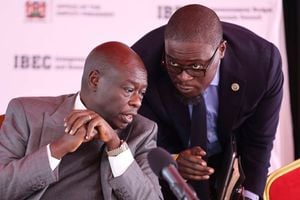There were half a million ghost voters in presidential election - Omtatah
By Sam Kiplagat
Busia senator-elect Okiya Omtatah claimed Wednesday that there are over half-a million votes that cannot be explained from the figures announced by the electoral commission after the August 9 General Election.
Making his submissions at the Supreme Court, Mr Omtatah said at least 508,687 ‘ghost voters’ voted in the presidential election because the number cannot be explained. According to the activist, a number of Kiems kits were still transmitting data a day after voting was closed, saying it might have been an avenue to add the ghost voters.
He further claimed that 1,665,412 people curiously voted between 5pm and 8:45pm on August 9. The activist explained that the spike in votes is not possible if it is factored that most voters had cast their votes by close of voting at 5pm.
“And without disclosing the alleged polling stations involved, this data hides the total number of polling stations that were allegedly still identifying voters via Kiems kits way beyond close of voting,” he said.
Mr Omtatah has argued that none of the presidential candidates reached the 50 per cent plus one vote threshold for a win.
“The manipulations of figures as expressed in Form 34C, where the total valid votes as attributed to the four candidates vary from the total cast votes as captured by the IEBC is possible only where votes are counted manually as opposed to a technical system which should be accurate,” he said.
He presented a table in court showing that when the rejected votes as contained in Form 34C are subtracted from the total voter turnout, the resultant figure for valid votes is 14,213,137.
“That is the exact figure that is registered in Form 34C, but which is erroneous because when the votes ascribed to each of the four candidates on Form 34C are added together they give a total of 14,213,027,” he said adding that in the circumstances, the only conclusion is that the figures were cooked.
He said the conflicting figures for valid votes cast of 14,213,137 and 14,213,027 is evidence that the results were worked backwards to achieve a desired or predetermined outcome.
The activist said the general election was not simple, accurate, verifiable, secure, accountable and transparent, because the Kiems kits did not provide for digital voting once a voter completes verification.
Ideally, he said, the kits should automatically allow a voter to cast their vote and the vote counting process was not done automatically after the completion of voting time to make the voting prompt, efficient, fast, and secure.
“The 2022 elections were manual and not digital. The IEBC did not deploy technologies for holding tamperproof elections that are simple, accurate, verifiable, secure, accountable and transparent,” he said.


